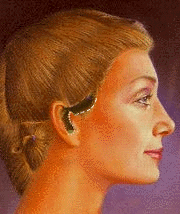As we age, our facial skin loosens and wrinkles and the muscles of the neck may weaken as well. Anything that will cause the skin to lose elasticity will hasten the process, including sun exposure, weight fluctuations and heredity. A facelift can address these problems by firming and tightening the skin of the face and neck all in one step. |
It is most effective for the lower face (jowls and neck). A double chin can be improved at the same time by supplemental lipectomy. To effect a more complete facial rejuvenation, facelifts are frequently done in conjunction with other procedures such as upper eyelid Blepharoplasty and lower eyelid Blepharoplasty. At times we also combine derma filler injection and Botox for deep wrinkles (forehead lines or frown lines or laugh lines). |
What is face lift? |
A face lift is a surgical procedure to improve visible signs of aging in the face and neck like
• Sagging in the mid face
• Deep creases below the lower eyelids
• Deep creases along the nose extending to the corner of the mouth
• Fat that has fallen or is displaced
• Loss of muscle tone in the lower face may create jowls
• Loose skin and excess fatty deposits under the chin and jaw can make even a person of normal weight appear to have a double chin.
While a facelift cannot stop the aging process, it can often make a person appear to be a decade younger than their actual age.
While a facelift cannot stop the aging process, it can often make a person appear to be a decade younger than their actual age.
|
What is short scar lift? |
The principle difference between a short-scar lift and other, "traditional" facelift is that the short-scar lift features a significantly reduced scar burden. The scarring in the crease behind the ear and in the hairline behind the ear is largely or completely eliminated.
The procedure is a multi-layer, multi-vector lift where the internal soft tissue structures (the so-called "SMAS" layer and malar fat pad) are adjusted separately from the overlying skin.
|
  |
How it is done? |
The incision begins in the hair near the temple and continues in front of the ear. The muscles and sagging tissue are tightened, excess skin is removed, and the remaining skin is repositioned to create a more youthful look. |
Who are the best
candidates for short-scar
face lifts? |
The short-scar lift is most applicable to patients in whom correction of mid-facial aging is the primary concern. Younger people in their 40s and 50s with minimal to moderate excess skin who do not need major neck work. This procedure is also ideal for someone who wants to minimize scars. |
Limitations |
Short-scar lift is more limited in its ability to provide correction of loose and sagging skin and soft tissue in the neck in comparison to more traditional lifts. |
Pre operative instructions |
You need to stop taking certain medications like aspirin, non-steroidal anti-inflammatory drugs (NSAIDs), blood thinners, certain herbal and natural medicines too (vitamin E, omega-3 fatty acids, green tea and gingko biloba all may increase bleeding risk during and after face lift surgery).
(Never stop taking any medication abruptly without first speaking to doctor)
Quitting smoking before your facelift is a must. Smoking reduces blood flow to areas of the face. As a result, one in ten smokers will experience skin death (necrosis) at the incision sites if they continue to smoke before and after surgery.
|
Anesthesia |
Local anesthesia
local + sedation
General anesthesia
|
Hospital stay |
Outpatient / 1-2 days |
Recovery |
7-10 days
After surgery, the head and face will be loosely bandaged to help reduce swelling and bruising.
A drainage tube may be inserted behind the patient’s ear to prevent blood and fluid from collecting under the skin.
Pain medication is usually used to make the patient feel as comfortable as possible following surgery.
Expect some postoperative swelling, numbness, and skin discoloration for about two weeks.
All incisions and dressings should be kept dry until the surgeon indicates that showering or bathing is okay.
For the first few days, the head should be kept elevated and immobile in order to minimize swelling.
Most stitches will be removed in about 6-7 days
|
Risk |
Although face lift surgery is one of the safest cosmetic procedures available, any operation comes with the possibility of complications. Some of the most common postoperative face lift complications are :
• Reaction to the anesthesia – some face lift patients experience nausea and general sickness after receiving anesthesia; this is a short-lasting side effect and usually diminishes completely after a few hours.
• Hematoma – if bleeding occurs under the skin, a hematoma can develop, leaving the area painfully swollen; an operation is required to stop the flow and remove the blood.
• Bleeding – although some light, postoperative bleeding is normal.
• Infection – typically occurring in a specific area, symptoms of infection are swelling, sensitivity, redness, and localized heat. Unless it is severe, an infection can be relieved with antibiotics.
Risks Specific to Face Lift Surgery
Aside from the risks inherent in any surgical procedure, risks specific to face lift surgery include :
• Injury to the nerves that control facial muscles - this is usually temporary.
• Problems with healing of the skin - this is common for patients who smoke.
• Scarring - there will be some scarring, although the surgeon will always try to hide the face lift scars.
• Crust on the incisions - this will be temporary.
|
Result |
Though a face lift is not a permanent solution to aging — your new and improved appearance will age, just as your original one did — it can set back the clock by several years. |